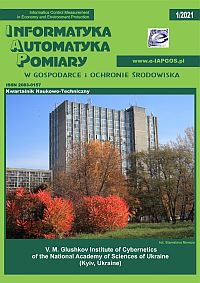DEVELOPING SOLUTION FOR USING ARTIFICIAL INTELLIGENCE TO OBTAIN MORE ACCURATE RESULTS OF THE BASIC PARAMETERS OF RADIO SIGNAL PROPAGATION
Article Sidebar
Open full text
Issue Vol. 11 No. 1 (2021)
-
THE SYSTEM FOR COMPLEX MAGNETIC SUSCEPTIBILITY MEASUREMENT OF NANOPARTICLES WITH 3D PRINTED CARCASS FOR INTEGRATED RECEIVE COILS
Mateusz Midura, Przemysław Wróblewski, Damian Wanta, Grzegorz Domański, Mateusz Stosio, Jacek Kryszyn, Waldemar T. Smolik4-9
-
MAGNETOELECTRIC COUPLING MEASUREMENT TECHNIQUES IN MULTIFERROIC MATERIALS
Jakub Grotel10-14
-
METHODS FOR DETECTING FIRES IN ECOSYSTEMS USING LOW-RESOLUTION SPACE IMAGES
Valerii Shvaiko, Olena Bandurka, Vadym Shpuryk, Yevhen V. Havrylko15-19
-
GENERATING FIRE-PROOF CURTAINS BY EXPLOSION-PRODUCTION OF WATER AEROSOL AS AN ELEMENT OF FIRE-SAFETY ENGINEERING
Grzegorz Śmigielski20-23
-
METHODS FOR ASSESSMENT AND FORECASTING OF ELECTROMAGNETIC RADIATION LEVELS IN URBAN ENVIRONMENTS
Denys Bakhtiiarov, Oleksandr Lavrynenko, Nataliia Lishchynovska, Ivan Basiuk, Tetiana Prykhodko24-27
-
METHOD FOR DETERMINING THE ACTUAL PRESSURE VALUE IN A MV VACUUM INTERRUPTER
Michał Lech, Damian Kostyła28-31
-
OVERVIEW OF FEATURE SELECTION METHODS USED IN MALIGNANT MELANOMA DIAGNOSTICS
Magdalena Michalska32-35
-
DEVELOPING SOLUTION FOR USING ARTIFICIAL INTELLIGENCE TO OBTAIN MORE ACCURATE RESULTS OF THE BASIC PARAMETERS OF RADIO SIGNAL PROPAGATION
Andrii Shchepak, Volodimir Parkhomenko, Vyacheslav Parkhomenko36-39
-
APPLICATION OF THE MATRIX FACTOR ANALYSIS METHOD FOR DETERMINING PARAMETERS OF THE OBJECTIVE FUNCTION FOR TRANSPORT RISK MINIMIZATION
Serhii Zabolotnii, Sergii Mogilei40-43
-
DESCRIPTION OF ALGORITHMS FOR BALANCING NUMERICAL MATRICES AND THEIR DIVISION INTO HIERARCHICAL LEVELS ACCORDING TO THEIR TYPE AND COMPLEXITY
Yuriy Khanas, Michał Borecki44-49
-
POLYPARAMETRIC BLOCK CODING
Julia Milova, Yuri Melnik50-53
-
NO-CODE APPLICATION DEVELOPMENT ON THE EXAMPLE OF LOGOTEC APP STUDIO PLATFORM
Monika Moskal54-57
-
THE TRAINING APPLICATION BASED ON VR INTERACTION SCENARIOS – WITH EXAMPLES FOR LOGISTICS
Wojciech Wlodyka, Dariusz Bober58-61
-
INVESTIGATION OF THE DEPENDENCE OF THE STRUCTURE OF SHIFT INDEXES VECTORS ON THE PROPERTIES OF RING CODES IN THE MOBILE NETWORKS OF THE INTERNET OF THINGS
Vladislav Kravchenko, Olena Hryshchenko, Viktoriia Skrypnik, Hanna Dudarieva62-64
Archives
-
Vol. 13 No. 4
2023-12-20 24
-
Vol. 13 No. 3
2023-09-30 25
-
Vol. 13 No. 2
2023-06-30 14
-
Vol. 13 No. 1
2023-03-31 12
-
Vol. 12 No. 4
2022-12-30 16
-
Vol. 12 No. 3
2022-09-30 15
-
Vol. 12 No. 2
2022-06-30 16
-
Vol. 12 No. 1
2022-03-31 9
-
Vol. 11 No. 4
2021-12-20 15
-
Vol. 11 No. 3
2021-09-30 10
-
Vol. 11 No. 2
2021-06-30 11
-
Vol. 11 No. 1
2021-03-31 14
-
Vol. 10 No. 4
2020-12-20 16
-
Vol. 10 No. 3
2020-09-30 22
-
Vol. 10 No. 2
2020-06-30 16
-
Vol. 10 No. 1
2020-03-30 19
-
Vol. 9 No. 4
2019-12-16 20
-
Vol. 9 No. 3
2019-09-26 20
-
Vol. 9 No. 2
2019-06-21 16
-
Vol. 9 No. 1
2019-03-03 13
Main Article Content
DOI
Authors
Abstract
The article considers the methods of calculating radio signal power. The main factors influencing the distribution and their connection with the error in the calculations of the indicators' peak values are analyzed. The regularities of signal propagation and the correlation between the distance from the radio signal source and the ratio of noise to useful information are determined. These patterns allow us to develop a model of artificial intelligence, which improves the prediction of results compared to existing calculation methods. The obtained results present the efficiency of the offered method.
Keywords:
References
http://en.wikipedia.org/wiki/Fresnel_zone (available: 27.02.2021).
http://en.wikipedia.org/wiki/Overfitting (available: 27.02.2021).
Gafarov F. M., Halymanov A. F.: Artificial neural networks and their appendices. Kazan University Press, Kazan 2018.
Miura Y., Oda Y., Taka T.: Outdoor-to indoor propagation modelling with the identification of path passing through wall openings. IEEE 13th PIMRC 1/2002, 130–134. DOI: https://doi.org/10.1109/PIMRC.2002.1046675
Parkhomenko V. L.: Basics of television and radio broadcasting. State University of Telecommunications, Kyiv 2017.
Rudoy G. I.: The Choice of the Activation Function in the Prediction of Neural Networks. Journal of Machine Learning and Data Analysis 1(1)/2011, 16–39 [http://jmlda.org/papers/doc/2011/no1/Rudoy2011Selection.pdf].
Article Details
Abstract views: 393
License

This work is licensed under a Creative Commons Attribution-ShareAlike 4.0 International License.






